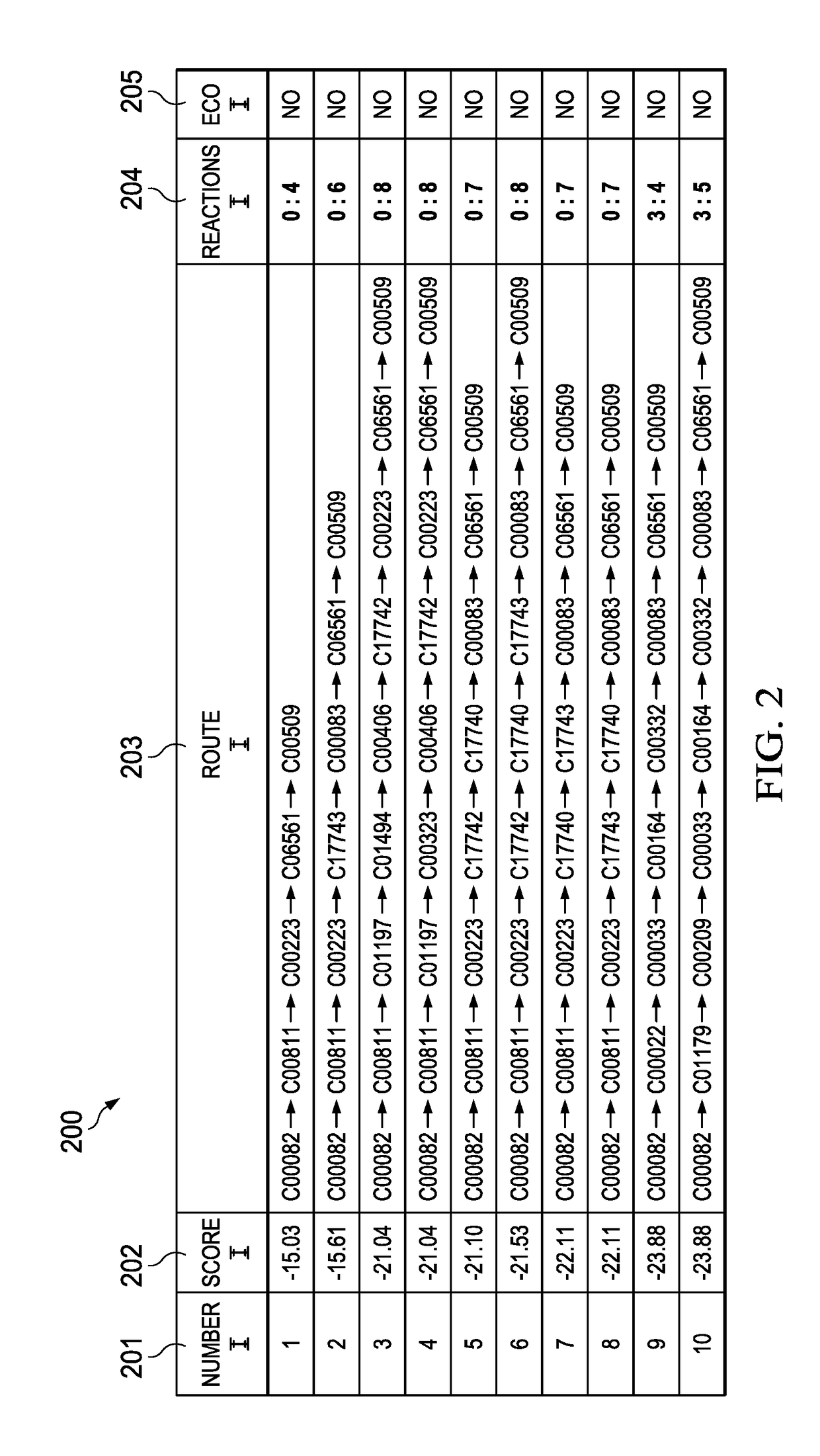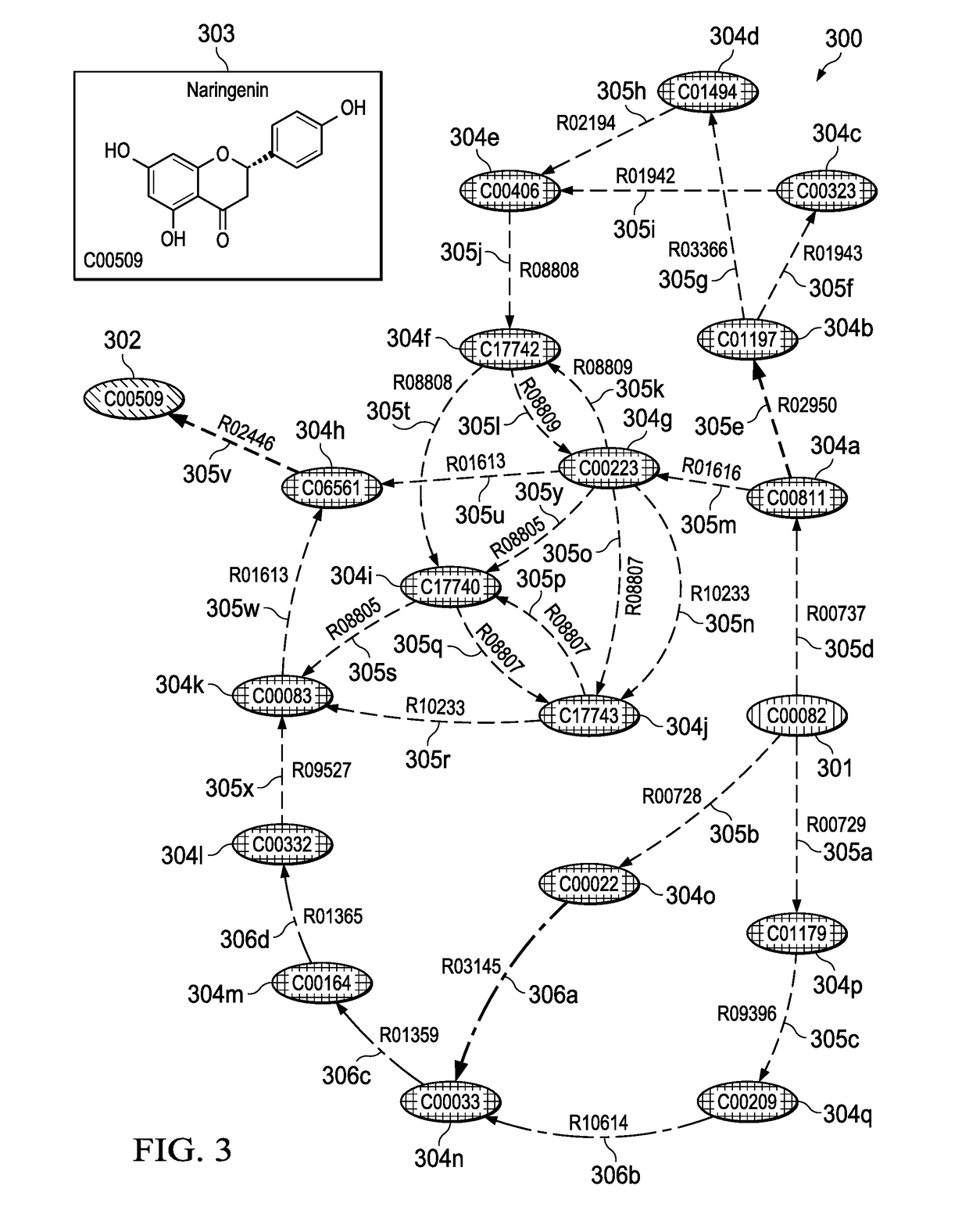These prior art graphical systems fail to account for essential analytical functionality of host parameters that is needed to accurately calculate biosynthesis pathways in a high speed system with accuracy and enhanced
usability.
Known graphical user display systems do not accurately calculate biosynthesis pathways considering this suitability of pathways for the
endogenous metabolism of a host
organism to maximize speed of the system with accuracy and enhanced
usability, which means known systems are not as accurate as possible concerning the design decision of introduction of foreign metabolic genes into a given host
organism.
For instance, several known
graphical display systems do not allow the user to specify a host organism in the determination of pathways of construction for a
natural product using biosynthesis, such as the graphical systems known as BNICE, PredPath and Metabolic tinker, which were developed to explore pathways irrespective of the consideration for host organisms.
These graphical systems cannot assess the suitability of pathways in a specific context without appropriately considering the introduction foreign metabolic genes into a given host organism or considering the endogenous metabolic system of a host organism.
Therefore, these prior art
graphical display systems fail to account for essential functionality that is needed to accurately calculate suitability of biosynthesis pathways in a high speed system with accuracy and enhanced usability.
Several other known graphical display systems do not adequately analyze the basis for the
chemical transformation of intermediate precursors that form metabolic routes in a pathway display, such as the FMM, DESHARKY and Metabolic tinker display systems (in Table 1a, above), which specify
chemical transformation using metabolic reaction sets from databases.
Through the use of metabolic reaction sets from databases, these display systems that do not adequately consider the basis for
chemical transformation of intermediate precursors that forms metabolic routes.
The above display systems do not adequately consider the basis for chemical transformation of intermediate precursors that form metabolic routes, but instead consider only reaction sets from databases.
For that reason, these graphical display systems cannot adequately assess the suitability of pathways in a specific context without appropriately considering the introduction foreign metabolic genes into a given host organism or considering the endogenous metabolic system of a host organism.
Therefore, these prior art graphical display systems fail to account for essential functionality that is needed to accurately calculate suitability of biosynthesis pathways in a high speed system with accuracy and enhanced usability.
Other known graphical display systems do not adequately analyze the basis for the chemical transformation of intermediate precursors that form metabolic routes in a pathway display, such as graphical display systems that include BNICE (in Table 1a, above), PredPath (in Table 1a, above) and XTMS, which merely predict some generalized chemical transformation rules using such curated reaction sets and apply those generalized rules to expand potentially feasible metabolic routes.
Because these graphical systems only consider curated reaction sets and use generalized rules to expand on possible routes, these graphical display systems cannot adequately assess the suitability of pathways in a specific context without appropriately considering the introduction foreign metabolic genes into a given host organism or considering the endogenous metabolic system of a host organism.
Therefore, these prior art graphical display systems fail to account for essential functionality that is needed to accurately calculate suitability of biosynthesis pathways in a high speed system with accuracy and enhanced usability.
Other known graphical display systems do not adequately analyze the basis for the chemical transformation of intermediate precursors that form metabolic routes in a pathway display, such as Metabolic tinker (in Table 1a, above) and XTMS (in Table 1c, above), which use thermodynamic data to constrain the reaction directionality or to rank pathways based on their net favorability.
These systems do not adequately consider competing endogenous reactions; and, therefore, these graphical display systems cannot adequately assess the suitability of pathways in a specific context without appropriately considering the introduction of foreign metabolic genes into a given host organism or considering the endogenous metabolic system of a host organism.
Therefore, these prior art graphical display systems fail to account for essential functionality that is needed to accurately calculate suitability of biosynthesis pathways in a high speed system with accuracy and enhanced usability.
Because these graphical display systems are restricted in the type of host organism to be evaluated, these graphical display systems cannot adequately assess the suitability of pathways in a specific context without appropriately considering the introduction of foreign metabolic genes into a given host organism or considering the endogenous metabolic system of a host organism.
Therefore, these prior art graphical display systems fail to account for essential functionality that is needed to accurately calculate suitability of biosynthesis pathways in a high speed system with accuracy and enhanced usability.
Some other graphical display systems, such as FMM and PHT, allow the user to select a host organism from a large set of choices, but these graphical display systems do not use the
chassis information to rank suitable biosynthesis pathways for a given endogenous metabolic system.
Because these systems do not use the
chassis information to rank suitable biosynthesis pathways for a given endogenous metabolic system, these graphical display systems cannot adequately assess the suitability of pathways in a specific context without appropriately considering the introduction of foreign metabolic genes into a given host organism or considering the endogenous metabolic system of a host organism.
Therefore, these prior art graphical display systems fail to account for essential functionality that is needed to accurately calculate suitability of biosynthesis pathways in a high speed system with accuracy and enhanced usability.
Overall, known methods and systems for displaying biosynthesis pathways for natural products, for the most part, simply select and display data for disclosure on a
graphical user interface, but these known systems do not accurately or adequately analyze pathways for biosynthesis by properly considering introduction of foreign metabolic genes into a given host organism or the endogenous metabolic system of a host organism.
All of these known graphical display systems cannot adequately assess the suitability of pathways in a specific context without appropriately considering the introduction of foreign metabolic genes into a given host organism or considering the endogenous metabolic system of a host organism.
For the above reasons, these prior art graphical display systems fail to account for essential functionality that is needed to accurately calculate suitability of biosynthesis pathways in a high speed system with accuracy and enhanced usability.
 Login to View More
Login to View More  Login to View More
Login to View More 


